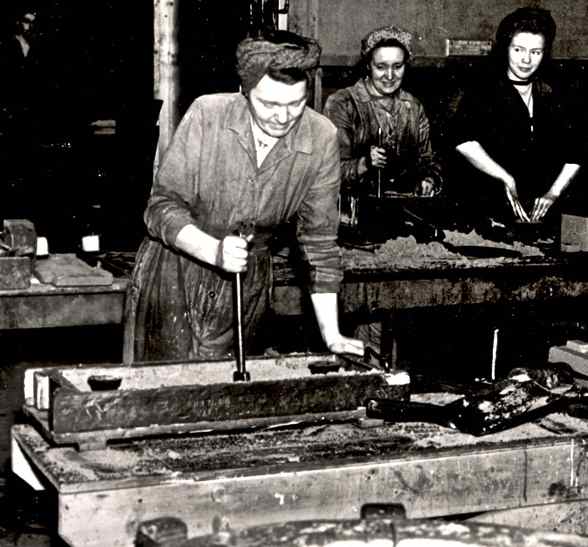
Detail from Coremakers, Vickers Armstrong Limited, Newcastle upon Tyne, around 1940. Newcastle Libraries, image ref: 064411.
Today, looking at the Tyneside Life and Times collection of photographs that Newcastle Libraries has put on Flickr, I saw this wonderful photograph. Since it is International Women’s Day today (8th March 2010), it seemed appropriate to write about a chance and very memorable encounter I had a few years ago. I cannot recall if she told me her name, but it may have been Annie.
It was a busy lunchtime in a department store café. The rather shabby and ordinary little old lady seemed shy when I asked if she minded my sharing the table with her.
We started to chat. She apologised for ‘not speaking clearly.’ It was obvious from the way that she pronounced words that she was deaf. I assured her I was able to understand her well, and told her a little about my work. I was selecting photographs to be digitised. That day, I was looking through photographs of women working during wartime. Upon hearing this, she somewhat hesitantly started to tell me about her life.
Annie had been born deaf. Her family considered that no man would want to marry her because she was deaf. She had to look after her father and brothers, doing the housework and cooking. She also had to work in her father’s launderette. It was hard, physical work. Her father did not expect to have to pay her a proper wage. She lacked friends, partly because she was always busy working.
The war started. Before too long, there were not enough men to work in the factories and to fight. When they asked for women to do their patriotic duty, the little deaf laundress applied. She was put in the machine shop and, along with other women, she learned to use the lathes.
It was dirty work. She told me with a radiant smile that she had enjoyed the job. It was the one time in her life that she was the same as the other women her age. The machine shop was so noisy that nobody could hear anyone else talk, so they all had to talk in sign language or by lip-reading. She was just ‘one of the girls.’
The photograph above shows some of the women Annie quite possibly knew. It was the image I had in mind when she was describing her work in the Vickers Armstrong factory to me. She told me about the importance of keeping hair out of the way. Hair falling loose and down towards the metal lathe would be lethal. Those headscarves, tightly twisted, were for practical reasons, not fashion. The scarves protected the women from getting hair trapped in machinery. Hair could drag skulls into machinery before any fellow workers even noticed.
After the war, the men came back so the women were no longer needed to work in the factory. Annie had to go back to working in the launderette and being unpaid servant to her family, and to social isolation again.
Finally, our teapots were totally drained and cold, and we put our coats on to leave the department store café. Annie looked at me with bemusement and admitted that she had never told anybody her story, and was not sure why she had told me. I smiled and suggested that it was because I wanted to hear it.
I have always wished I had hugged Annie. She had spent most of her life feeling alone because of attitudes to her deafness. She was not bitter, however. She simply treasured the brief time during World War 2 when she had been in an environment where she was the same as other women.
I hope that when you look at the little old ladies you see every day in the street, in cafés, on the bus, that you will consider that they may have fascinating, extraordinary tales to tell about their lives.
